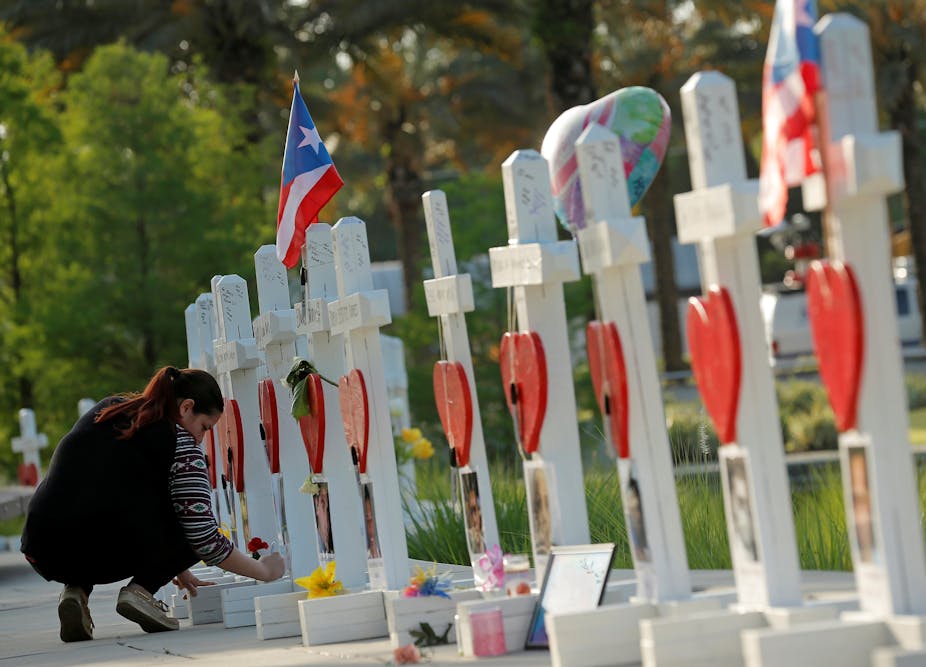The terrible tragedy that occurred in Orlando was an attack driven by hatred toward the lesbian, gay, bisexual, transgender and queer (LGBTQ) community. Unfortunately, this is not an isolated instance. Hate against the LGBTQ community is more widespread than many choose to believe.
As public health professionals working in sexuality and sexual health, we feel it is our responsibility to educate the public about the consistent threats that LGBTQ individuals face and to make the case that this is a public health issue. Hate directed at one community ultimately affects us all.
Twenty-one percent of hate crime victims are LGBTQ
LGBTQ populations are significantly more likely to be the victims of “single-bias” hate crimes or hate crimes motivated by a single cause or issue.
According to the FBI, in 2014, of 6,216 reported single-bias hate crimes, 21 percent resulted from sexual orientation bias and were targeted because of that identity. However, most incidents aren’t reported to the police.
On June 13, the National Coalition of Anti-Violence Programs (NCAVP), an organization that, in their words, “works to end violence against and within LGBTQ, and HIV-affected communities,” released their 2015 report outlining hate-driven violence reported by 13 NVACP member programs in 11 states.
This report is significant because hate crimes are often underreported to the police. Many LGBTQ individuals fear being revictimized by the criminal justice system, feel shame for being a victim or lack knowledge on victims’ rights and services. Because LGBTQ individuals may feel more comfortable reporting these crimes at NCAVP member organizations, the coalition can collect information that might not get reported to police.
What is hate-driven violence?
Incidents of violence against another person range from blackmail, eviction and talking to sexual violence and murder. Of the 1,253 incidents, detailed data was collected from 752 incidents.
Here are some of the key findings from the report:
- 62 percent of survivors knew the people who committed the hate crime
- there were 24 hate violence related homicides of LGBTQ and HIV-affected people in 2015 (a 20 percent increase from 2014)
- 47 percent of survivors identified as gay and 17 percent of survivors identified as lesbian
- 38 percent of survivors were youth and young adults
- 64 percent of survivors identified as people of color
- the most common types of hate violence reported were verbal harassment (15 percent), discrimination (14 percent), physical violence (12 percent) and threats or intimidation (11 percent)
- Only 41 percent of LGBTQ and HIV-affected survivors reported their experience of hate violence to police (compared to 54 percent in 2014).

Why hate is a public health problem
These individual acts of hate are indicative of a wider pattern of discrimination against the LGBTQ community. It is now recognized within public health that this discrimination causes significant health problems for the LGBTQ community.
For instance, hate and discrimination can become internalized and a source of chronic stress, which in turn is a risk factor for depression. And in fact, LGBTQ populations do experience higher rates of psychological distress and depression. In addition, chronic stress can disrupt normal biological functioning. This in turn can make people more susceptible to infection.
Related to this, men in long term same-sex relationships were significantly more likely to die from suicide than men who were married to women or men who were never married. The lifetime rate of suicide attempts among the LGBT population is four times higher than the rate of suicide attempts for non-LGBT people. This is most likely related to long-term depression and the impacted stigma and oppression LGBT people face on a regular basis.
Hate and discrimination also affect rates and progression of sexually transmitted infections (STIs), including HIV. Stigma against HIV - for instance, the perception that it is a “gay man’s disease” - still exists in our society. There is a fear of being labeled as HIV positive, which causes many people to avoid testing. The result is that many people who are HIV positive do not know that they are and are therefore more likely to spread the disease. Although men who have sexual contact with other men represent about four percent of the male population, they accounted for 78 percent of new HIV infections among men in 2010, and 63 percent of all new HIV infections.
Additionally, this fear of being tested for HIV often extends to a fear of being tested for other STIs. Eighty-three percent of new syphilis cases in 2014 affected men who have sexual contact with men.
Homelessness is more likely to affect LGBT youth – 20-40 percent of homeless youth identifying as LGBT. Many LGBT youth experience violent physical assault when they come out and may actually feel safer living on the streets.
Homophobia and intolerance affect everyone. This includes peoples who consider themselves straight, or who may not have friends or relatives in the LBGTQ community. It limits self-expression, prevents same-sex friends from showing affection toward each other, prompts people to act aggressively toward LGBTQ individuals to “prove” they are not part of the community and causes youth to prove their sexuality by having sex before they are ready. Homophobia and intolerance make it hard to appreciate anything that is outside the realm of what is considered “normal” in our society.
Public health includes organized measures to prevent disease, promote health and prolong life among the population as a whole. Researchers in the field of public health have long studied the effects of many kinds of discrimination on health; whether as a result of race, socioeconomic status or sexual orientation.
Although hate crime research is a relatively new area of public health, there is already a growing body of powerful evidence of its health consequences. We know the impacts of hate and discrimination. We know what perpetuates hate and discrimination. The next step is change.
For our part, we’ve launched a campaign on Twitter and Instagram using the hashtag #wechallengehate to educate people on how we can each stand up to hate.

